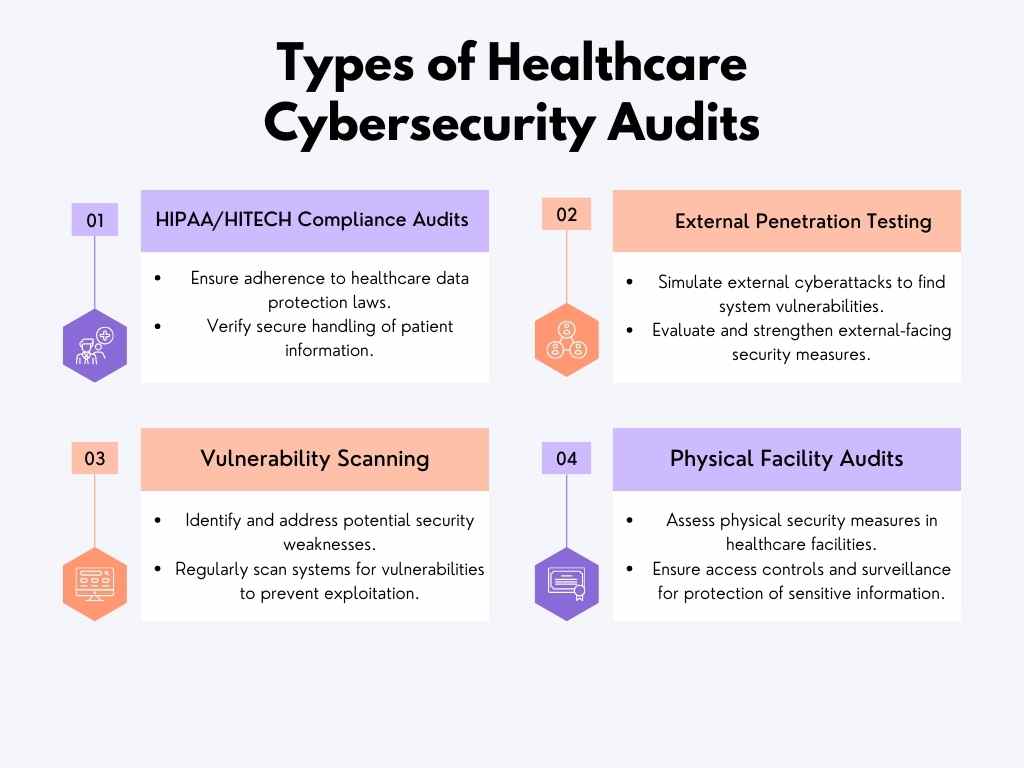Expanding digital healthcare attack surfaces now force providers to verify security defenses through independent audits. Various regulations also mandate more frequent verification of controls safeguarding sensitive patient information.
Yet audits labeled as necessary checkboxes often get approached haphazardly. Healthcare IT and security leaders may view them as painful, anxious exercises revealing only faults and budget gaps.
This guide offers advice on effectively managing assessments while maximizing their value for strengthening institutional cyber risk postures long term. Audits serve as transformational opportunities rather than unavoidable risks themselves when handled deliberately.
Table of Contents
Types of Healthcare Cybersecurity Audits

Four main audit varieties help quantify security program efficacy:
HIPAA/HITECH Compliance Audits
Federal regulators perform these periodically to validate healthcare provider data governance meets complex Health Insurance Portability and Accountability Act requirements.
Topics span technical defenses like access controls and encryption to administrative processes including staff training, contractor oversight and patient right preservation. Gaps can spur corrective action plans or prompt fines from The Office of Civil Rights.
External Penetration Testing
Ethical “white hat” hackers simulate real-world attacks attempting to breach networks, access systems and exfiltrate data assets through phishing attempts, unpatched software exploitation and similar techniques actual criminals leverage.
The goal is identifying overlooked access paths rather than wreaking real damage. Tests validate whether existing tools would halt infiltration progress at each potential break-in stage – and crucially where adversaries might still advance to impact operations or data stores.
Vulnerability Scanning
Automated scans provide inventories of connected devices, operating system versions, software flaws and misconfigurations assessed against benchmarks. Tools quantify the scope of upgrade or hygiene efforts required across IT environments and external-facing assets.
Physical Facility Audits
Assessors tour campuses searching for risks like open wiring closets, unsecured workstations, or monitoring gaps that could enable unauthorized data access. Reviews validate real-world defenses match stated policies and heighten staff security awareness.
Preparing Teams and Infrastructure for Assessments
Smooth audit execution requires appropriate expectations setting, transparency and planning. Key preparation steps involve:
Assembling Key Infrastructure Documentation
Detail existing security policies, controls procedures and technologies in place supporting HIPAA/HITECH standards mapped across each infrastructure domain. Gaps get remediated faster post-audit with current state visibility.
Educating Staff on Methodology
Overview objectives, scope, methods and timing to prevent surprise or confusion about assessor activities like social engineering attempts to steal credentials, accessing restricted areas, or intermittent systems downtime.
Planning Remediation Roadmaps
The most mature audit programs budget for short and longer term projects addressing expected gaps uncovered based on past results and current environments. Planning for quick fixes alongside modernization investments brings value realization forward.
Managing Assessment Activities Smoothly
Once audits commence, providing active assistance accelerates analyzer progress while optimizing learnings. Help assessors by:
Granting Access and Interview Time
Provide remote connectivity, badges or escorts as needed covering agreed scope like on-premise servers, cloud services, distribution centers and similar sites. Make key IT, security and other leaders available for inquiries.
Establishing Clear Engagement Rules
Define what methods assessors may deploy against production systems during testing, requirements for notifying staff regarding activities that could trigger alerts, approving tool installations, and expected communications practices.
Coordinating Schedules
Ensure resources align to support audit requests and maintain continuity of critical business activities. Adjustments occur if unforeseen conflicts arise on either end.
Reviewing Initial Findings
Preliminary observations get validated before analysis concludes and final reports with roadmaps emerge. Discuss technical feasibility or potential business impact of proposed remediations.
Maximizing Audit Investment Value
Too often, assessment reports collect dust once received rather than catalyzing improvement. Some guiding tenets on extracting ROI from audits include:
Treat Assessments as Transformational Programs
Set goals before engagements launch encompassing strengthening risk quantification, control efficacy, security team skill sets and similar areas tied to maturity goals. Track benefits over time.
Drive Lasting Mindset and Policy Shifts
Let evidence uncovered prompt permanent increases in cyber hygiene, data governance and infrastructure modernization investments. Elevate security as an institutional priority area fueled by audit findings.
Budget for Recommended Investments
Modernization requires allocating capital and resources against roadmap priorities over subsequent operating budget cycles. Multi-year planning recognizes transformations can’t occur overnight but do require persistent backing.
Make Assessments Regular Discipline
Finally, sustaining secure posture requires audits on an ongoing basis to catch drift from benchmarks. Core aspects of an enduring program involve:
Annual Testing Cadences
Regular penetration, vulnerability and compliance assessments validate that modernizations and process changes made endure while revealing new gaps that emerge over time.
Maintaining Audit Dashboards
Centralized tracking of benchmark achievement, historical findings and number of lingering remediations provides quantifiable visibility allowing managers to monitor progress.
Promoting Successes Internally
Let positive audit stories reinforce importance of sustaining budgetary and staff support rather than keeping reports buried. Progress made toward data security pays dividends beyond passing scores alone.
Conclusion
What gets measured gets improved holds true with healthcare cybersecurity audits. But realizing transformational potential takes upfront planning and commitment to power lasting enhancements after assessments conclude.
Audits serve as invaluable opportunities providing direction, evidence and motivation for strengthening institutional security postures aligned to patient safety and care quality goals. Treat the painful aspects as necessary moments driving elevated maturity.
FAQs
A network security audit is a comprehensive evaluation of the information systems in a healthcare setting. It assesses how well these systems protect patient data and comply with regulations like HIPAA.
It’s recommended to conduct these audits annually, or more frequently if major changes occur in the IT environment or in response to emerging threats.
Post-audit, healthcare organizations should prioritize addressing identified vulnerabilities, update their security protocols, and plan for regular follow-up audits.

